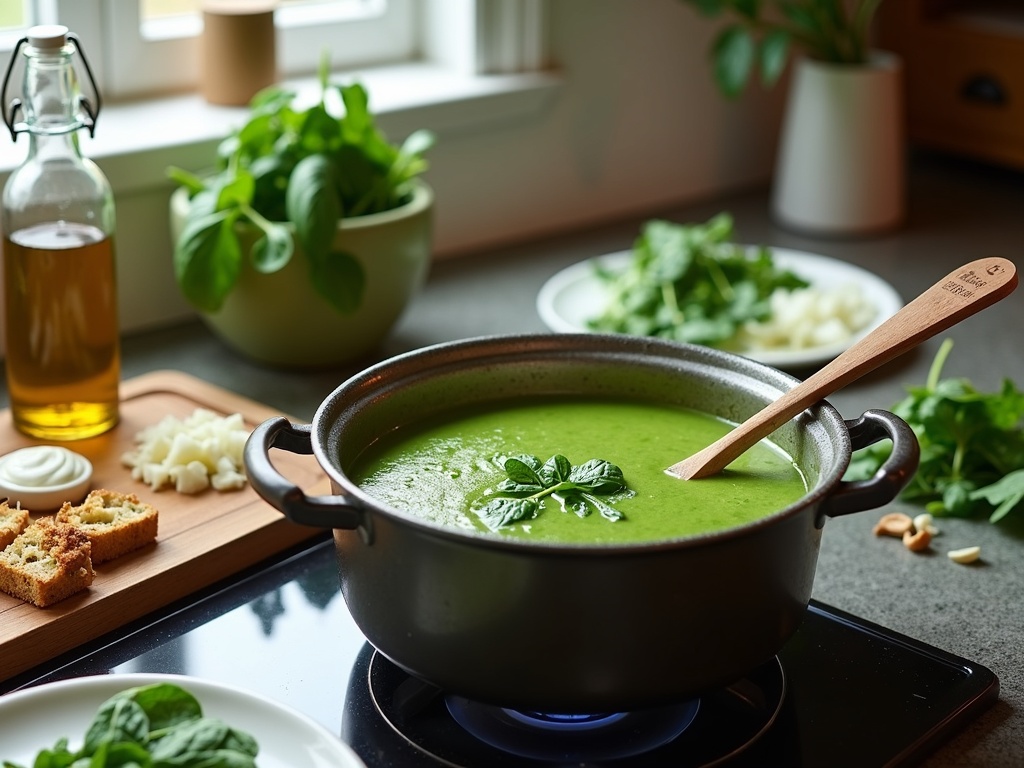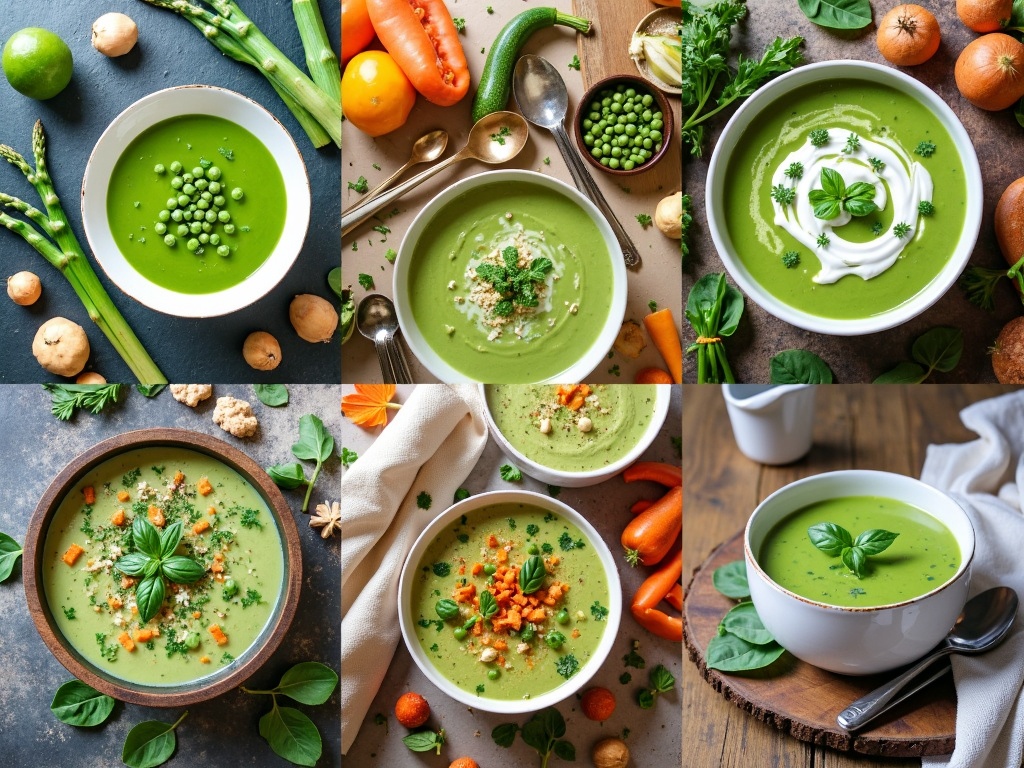Spinach soup delivers remarkable health benefits while staying at just 41 calories per cup of cooked spinach. This bright green soup offers more than 100% of daily vitamin K needs, substantial amounts of vitamins A and C, folate, and about 5 grams of protein per serving. Its antioxidant content fights oxidative stress and may lower chronic disease risk.
Find In This Article
Key Takeaways
- Spinach soup contains over 100% of daily vitamin K requirements, supporting bone health and proper blood clotting.
- With only 41 calories per cup of cooked spinach, it’s an ideal option for those watching their weight while seeking nutrient-dense foods.
- Each serving provides approximately 5 grams of protein along with significant amounts of vitamins A, C, and folate.
- The soup’s antioxidants (flavonoids and carotenoids) help combat oxidative stress and reduce cell damage.
- Spinach soup is versatile – it can be enjoyed hot in winter or chilled in summer, and customized with various herbs, spices, or a touch of cream.
Why This Nutrient-Packed Soup Is Good For You
Spinach soup isn’t just delicious—it’s a nutritional powerhouse that delivers incredible health benefits in every spoonful. I’ve found that incorporating this vibrant green soup into my meal rotation has been one of the smartest dietary choices I’ve made. The humble spinach leaf transforms into something magical when simmered into a warming soup, and your body will thank you for it.
Impressive Nutritional Profile
A single cup of cooked spinach contains over 100% of your daily vitamin K needs, making this soup fantastic for bone health and proper blood clotting. But that’s just the beginning of what spinach brings to the table. Each serving delivers significant amounts of vitamin A, vitamin C, and folate—nutrients that play crucial roles in immune function and keeping your skin healthy.
What makes spinach soup even more appealing is its calorie count. With only 41 calories per cup of cooked spinach, it’s an ideal option if you’re watching your weight or looking to add more nutrient-dense foods to your diet without excess calories. I love that I can enjoy a satisfying bowl without worrying about my calorie intake.
The antioxidant content in spinach soup is truly impressive, too. It’s packed with flavonoids and carotenoids that help combat oxidative stress and reduce cell damage. These powerful compounds work to neutralize harmful free radicals in your body, potentially lowering your risk of chronic diseases.
For those looking to increase their protein intake, spinach soup delivers approximately 5 grams of protein per serving. While that might not sound like much compared to meat or dairy products, it’s a significant amount for a vegetable and helps contribute to your daily protein needs.
The anti-inflammatory properties of spinach make this soup particularly valuable for heart health. Regular consumption may help reduce inflammation throughout the body and support cardiovascular function. If you’re looking for variations on green soups with similar benefits, celery soup offers anti-inflammatory benefits as well.
I often alternate between spinach soup and carrot soup for balanced nutrition, as both provide different but complementary nutrients. The beta-carotene in carrot soup pairs perfectly with the iron and folate in spinach soup for a well-rounded approach to health.
For those who enjoy hearty Italian-inspired soups, you can combine the benefits of spinach with other vegetables in a nutritious zuppa soup that delivers multiple health benefits in one bowl.
If you’re new to making vegetable soups, starting with a simple carrot soup recipe can help you master the techniques before moving on to spinach soup.
The beauty of spinach soup lies not just in its nutritional content but also in its versatility. You can enjoy it hot in winter for a warming meal or chilled in summer for a refreshing option. By adding different herbs, spices, or a touch of cream, you can create various flavor profiles while still retaining the incredible health benefits that spinach provides.
I’ve found that making a large batch of spinach soup at the beginning of the week gives me quick access to a nutritious meal option when I’m busy or not feeling up to cooking. The nutrients remain stable when properly stored, making it a convenient way to ensure I’m getting important vitamins and minerals even on hectic days.
Essential Ingredients and Their Purpose
Fresh spinach is the star of a delicious spinach soup, bringing both vibrant flavor and incredible nutritional benefits. I recommend using 4-6 cups of either savoy or flat-leaf varieties depending on what’s available at your local market. The spinach provides not only the signature green color but also packs in vitamins A, C, K, and folate that make this soup a truly healthy option.
The foundation of great flavor starts with aromatics. One medium onion (yellow, red, or shallots) creates depth and natural sweetness as it cooks down. Two cloves of garlic add that unmistakable punch while bringing immune-boosting properties to your bowl. I find that sautéing these ingredients first helps release their essential oils and creates layers of flavor before the spinach even enters the pot.
Liquid Base and Creaminess
The backbone of any good soup is its liquid component. Four cups of vegetable broth forms the base, ideally made with carrots, celery, and herbs for a full-bodied flavor. If you’re short on time, carrot soup stock can make an excellent substitute that adds a hint of sweetness.
For creaminess, add ½ cup of your preferred dairy or non-dairy option. Traditional recipes call for heavy cream, but coconut cream or almond milk work beautifully for those wanting plant-based alternatives. The creaminess balances the earthiness of the spinach and creates that velvety texture that makes zuppa soup variations so comforting.
Basic seasonings bring everything together. Salt and pepper are essential, but don’t overlook the magic of a pinch of nutmeg which pairs remarkably well with spinach. For those who enjoy a bit of heat, a dash of cayenne pepper can transform the soup entirely.
The beauty of spinach soup lies in its versatility. You can easily incorporate other vegetables like celery soup ingredients for added complexity, or follow a carrot soup recipe approach by roasting some of your vegetables first to intensify their flavors.
Each ingredient serves a specific purpose in creating a harmonious balance of flavors, textures, and nutrients. The result is a soup that’s not just delicious but also packed with goodness that nourishes from the inside out.
How to Make Perfect Spinach Soup
Creating a silky, flavor-packed spinach soup is easier than you might think. The vibrant green color and nutrient-rich profile make this soup a fantastic option for both everyday meals and special occasions. I’ve refined this process to give you consistent results every time.
Step-by-Step Preparation
The key to outstanding spinach soup starts with proper preparation. First, thoroughly wash your spinach leaves under cold running water to remove any dirt or grit. Take time to pick through the leaves and remove any thick, tough stems that could affect the soup’s smooth texture. Pat the spinach dry with paper towels or use a salad spinner if you have one.
In a large pot, heat a generous splash of olive oil over medium heat. Add finely diced onions and minced garlic, then sauté until they become translucent and aromatic – typically about 3-4 minutes. Be careful not to brown the garlic as it can become bitter.
Next comes the star ingredient – add your prepared spinach to the pot. Though it might seem like an enormous amount, spinach reduces dramatically during cooking. Stir frequently as the spinach wilts down, which should take approximately 3-5 minutes.
Once the spinach has completely wilted, pour in your broth of choice. Vegetable broth works wonderfully for a fully vegetarian option, but chicken broth can add extra depth of flavor. Bring the mixture to a gentle simmer and let it cook for 10-15 minutes to marry the flavors.
After simmering, it’s time to transform your mixture into that velvety consistency that makes good soup so comforting. An immersion blender works perfectly here – simply blend directly in the pot until smooth. If you don’t have an immersion blender, carefully transfer the mixture to a standard blender in batches.
To finish your soup, stir in a splash of cream (or coconut cream for a dairy-free alternative) and season with salt, pepper, and a pinch of nutmeg if desired. The cream adds richness while balancing the earthiness of the spinach.
For serving, I recommend these garnishing options:
- A swirl of sour cream or Greek yogurt
- A sprinkle of toasted pine nuts
- Fresh herbs like dill or chives
- Homemade croutons for delightful crunch
This spinach soup recipe shares techniques found in other vegetable soups. If you enjoy this, you might also appreciate the similar methods used in celery soup or carrot soup recipes that use the same foundations of sautéed aromatics and puréed vegetables.
The beauty of this spinach soup lies in its versatility. For a heartier version, add white beans before blending. For extra brightness, squeeze in fresh lemon juice just before serving. You can even adjust the thickness to your preference by adding more or less broth.
Temperature affects how we perceive flavors, so taste and adjust seasonings after the soup has reached its final temperature. Sometimes a soup that tastes perfectly seasoned while hot might need additional salt once cooled slightly.
This method creates a consistently delicious spinach soup that’s sure to impress. The vibrant green color makes it visually appealing, while the smooth texture and balanced flavors create a satisfying soup experience that works as a starter or light main course.

What You Get in Each Bowl
I’ve found spinach soup to be an incredible nutritional powerhouse that delivers amazing benefits with every spoonful. A typical cup serving contains just 80 calories, making it perfect for anyone watching their caloric intake while still wanting something satisfying and warming.
Macronutrient Profile
Each bowl provides a balanced mix of essential macronutrients. You’ll get 5g of plant-based protein, which helps with muscle maintenance and repair. The 12g of carbohydrates provide energy without causing blood sugar spikes, especially considering the 2.5g of fiber that slows digestion and promotes gut health. This fiber content also contributes to the low glycemic index (below 55) of spinach soup, making it an excellent choice for maintaining stable blood sugar levels.
For comparison, celery soup typically has fewer calories but also less protein, while carrot soup offers different nutritional benefits with its higher beta-carotene content.
Vitamin and Mineral Density
The micronutrient profile of spinach soup is where it truly shines. Each serving delivers an impressive:
- 540% of your daily vitamin K needs, supporting bone health and proper blood clotting
- 200% of daily vitamin A requirements, essential for vision, immune function, and cell growth
- 30% of your daily iron needs, helping transport oxygen throughout your body
These exceptional nutrient levels make spinach soup stand out among other soup options. The iron content is particularly valuable for those following plant-based diets who might struggle to meet their daily requirements.
I’ve noticed that spinach soup tends to be more nutrient-dense than many other vegetable soups. While zuppa soup might offer more protein if it contains beans or meat, it typically can’t match the vitamin K and A levels of a spinach-based soup.
The versatility of spinach soup also means you can customize it with additional ingredients to boost specific nutrients. Adding beans increases protein content, while incorporating carrot soup recipes can enhance the vitamin A profile even further.

Seasonal Ways to Enjoy It
Spinach soup offers incredible versatility throughout the year. I’ve discovered that adapting this nutritious dish to include seasonal ingredients not only enhances its flavor but also maximizes nutritional benefits while supporting local agriculture.
Spring and Summer Variations
In spring, I love transforming my basic zuppa soup recipe by adding tender spinach alongside fresh spring produce. Adding just-picked garden peas creates a vibrant sweetness that pairs beautifully with the earthy spinach base. Asparagus spears, chopped and added during the last few minutes of cooking, introduce a delicate texture and distinctive flavor that screams springtime.
Summer calls for a lighter approach to spinach soup. I often incorporate:
- Fresh herbs like basil, mint, or cilantro for brightness
- A squeeze of lemon juice to add refreshing acidity
- Zucchini or summer squash for substance without heaviness
- Chilled serving options for hot days (try it with a dollop of yogurt!)
The addition of mint makes the soup particularly refreshing during warmer months, while basil creates a wonderful bridge between spinach and summer tomatoes if you choose to add them.
Fall and Winter Comfort
When autumn arrives, my carrot soup with spinach becomes a staple. I enhance spinach soup with warming spices like nutmeg, cinnamon, or a pinch of cumin to create a comforting bowl. Root vegetables such as sweet potatoes, parsnips, or turnips add hearty substance perfect for cooler weather.
For the best results with seasonal cooking, I recommend visiting farmers’ markets to discover what’s freshly harvested. This approach guarantees the highest nutritional content and flavor in your soup. Talking directly with farmers can yield unexpected inspiration for your next carrot soup recipe variation with spinach.
To prevent waste, proper storage is crucial. I freeze portions of spinach soup in individual containers for quick meals later. For fresh spinach awaiting use, store it with a paper towel in a loosely closed bag to absorb excess moisture. This technique works equally well for celery soup ingredients and extends shelf life significantly.
By adjusting ingredients seasonally, you’ll never grow tired of spinach soup. Each version offers unique flavors and nutritional benefits while making the most of nature’s ever-changing bounty.

Sources:
Harvard T.H. Chan School of Public Health, “Spinach: Health Benefits.”
USDA National Nutrient Database, “Nutritional Information for Spinach Soup.”
“The Ultimate Guide to Spinach Recipes,” Healthline.

